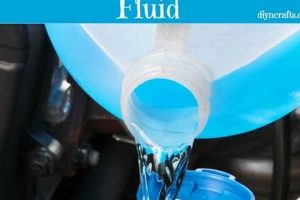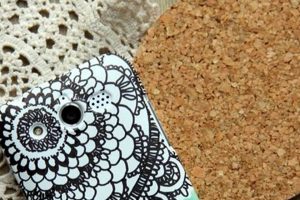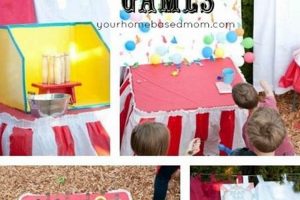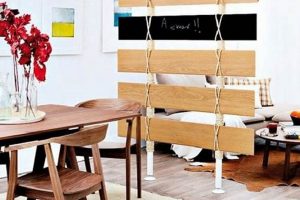The creation of floral headwear, often achieved through do-it-yourself methods, involves assembling natural or artificial flowers and foliage onto a base, typically wire or ribbon. This craft allows for personalized adornment suitable for various occasions, ranging from casual outdoor gatherings to formal events. For example, an individual may select specific blooms to match a color scheme or theme, integrating them onto a flexible wire frame to achieve a bespoke design.
The significance of constructing such headpieces lies in their capacity for self-expression and customization. This practice promotes creativity and resourcefulness, often resulting in a unique accessory that reflects individual style. Historically, floral head adornments have symbolized celebration, purity, and connection to nature, appearing in cultural traditions and artistic representations across different eras and societies. The act of making these items provides an engaging and cost-effective alternative to purchasing commercially produced accessories.
The following sections will delve into the materials required, step-by-step instructions, and design considerations for constructing personalized floral headpieces. Furthermore, guidance will be provided on preserving and maintaining the finished product to ensure longevity. The discussion will also explore adapting the basic techniques to create variations suitable for different ages and skill levels.
Constructing Floral Headwear
The creation of floral head adornments necessitates careful planning and execution to achieve optimal results. Adhering to the following guidelines will enhance the quality and longevity of the finished product.
Tip 1: Bloom Selection. Prioritize the selection of fresh, unblemished flowers. Hydrated blooms will maintain their vibrancy and structure throughout the intended period of wear. Consider the weight and durability of different flower types to ensure comfortable and secure placement.
Tip 2: Wiring Techniques. Employ floral wire of appropriate gauge to securely attach stems to the base. Ensure that the wire is concealed effectively to prevent discomfort or detract from the aesthetic appeal. Practice wiring techniques beforehand to minimize waste and improve efficiency.
Tip 3: Base Construction. Select a robust and flexible base material, such as floral wire or a pre-made headband. Ensure the base is appropriately sized to provide a comfortable and secure fit without causing undue pressure or slippage.
Tip 4: Foliage Integration. Incorporate greenery to add texture and visual interest. Choose foliage that complements the flowers in terms of color and shape. Securely attach foliage to the base to prevent shedding or drooping.
Tip 5: Design Symmetry and Balance. Strive for visual equilibrium in the arrangement of floral elements. Distribute flowers and foliage evenly across the base, paying attention to color distribution and overall shape. Consider the intended viewing angle when assessing the design’s symmetry.
Tip 6: Securing the Design. After completing the arrangement, reinforce the attachment of all floral elements with additional wire or floral tape. This step is crucial for preventing dislodgement during wear, especially in active environments.
Tip 7: Hydration and Preservation. To prolong the life of fresh floral headwear, mist the arrangement lightly with water and store it in a cool, dark place when not in use. Consider using floral preservatives to enhance hydration and retard wilting.
Mastering these techniques empowers the artisan to craft durable and aesthetically pleasing floral headpieces. Proper execution of these steps will result in an accessory that complements various occasions and attire.
These foundational principles serve as a springboard for further exploration of advanced design techniques and material variations, paving the way for the creation of increasingly elaborate and personalized floral adornments.
1. Bloom Selection
The selection of appropriate blooms is paramount in the successful construction of floral headwear. This process extends beyond mere aesthetic preference, influencing the durability, structural integrity, and overall visual impact of the finished piece. Careful consideration of bloom characteristics is essential to ensure a satisfactory outcome.
- Durability and Resilience
The lifespan of fresh floral headwear is directly correlated with the selected bloom’s inherent durability. Blooms prone to rapid wilting or easy bruising, such as delicate orchids or thin-petaled varieties, may compromise the overall longevity of the piece. Conversely, robust options like carnations or chrysanthemums offer greater resilience and extended wear time. The intended duration of use should thus inform the choice of floral species.
- Structural Integrity and Weight
The weight and structural characteristics of blooms impact the stability and comfort of the headwear. Excessively heavy flowers can cause discomfort and imbalance, particularly when combined with other embellishments. Sturdy blooms with strong stems provide a more secure anchor point for wiring and attachment, contributing to the overall structural integrity of the piece. Lighter-weight alternatives should be considered when aiming for a more delicate or minimalist aesthetic.
- Color Palette and Aesthetic Harmony
Bloom selection dictates the overall color palette and aesthetic harmony of the headwear. A cohesive color scheme enhances the visual appeal and ensures the piece complements the wearer’s attire or the intended occasion. Consideration of color theory, including complementary and analogous color relationships, is essential for achieving a visually pleasing outcome. The deliberate contrast or coordination of floral colors can significantly impact the headwear’s overall impact.
- Seasonal Availability and Cost-Effectiveness
The seasonal availability of specific blooms directly impacts their cost and accessibility. Opting for flowers that are in season reduces expenses and ensures optimal freshness. Furthermore, considering the overall budget is crucial when making bloom selections. Cost-effective alternatives that maintain the desired aesthetic can be substituted without compromising the visual appeal or structural integrity of the headwear. A balanced approach to bloom selection considers both aesthetic preferences and practical considerations.
In summation, bloom selection is not a superficial element but rather a critical determinant of the quality and longevity of floral headwear. A thorough assessment of durability, structural integrity, color harmony, and cost-effectiveness ensures the creation of a visually appealing and enduring accessory. This thoughtful approach transforms the simple act of choosing flowers into a cornerstone of successful floral headwear construction.
2. Base Material
The selection of a suitable base material is a fundamental consideration in the construction of a floral headpiece. This component provides the structural foundation upon which the floral elements are arranged and secured. The choice of material directly impacts the comfort, durability, and overall aesthetic of the finished product.
- Structural Support and Form
The base material determines the shape and rigidity of the floral headwear. Options range from flexible wire frames to rigid headbands, each offering distinct structural properties. A wire frame allows for adjustable sizing and a more organic, flowing design, while a headband provides a fixed form and greater stability. The intended style and the weight of the floral elements should guide the selection of an appropriate support structure. Consider the impact on balance and wearability; an improperly chosen base can lead to discomfort or instability.
- Material Compatibility and Durability
Different base materials exhibit varying degrees of compatibility with floral attachment methods and exposure to environmental factors. Wire, for instance, is easily manipulated and readily accepts floral wire or adhesives, but may be prone to corrosion or deformation over time. Fabric-covered headbands offer a comfortable and aesthetically pleasing surface, but may be more susceptible to staining or moisture damage. The chosen material should withstand the weight of the flowers and maintain its integrity throughout the intended period of use. Assess the long-term durability and maintenance requirements of each option.
- Aesthetic Integration and Concealment
The base material should seamlessly integrate with the floral arrangement, enhancing rather than detracting from the overall aesthetic. Options range from natural-looking twine or raffia to sleek metal or plastic. The chosen material can be concealed beneath the floral elements or intentionally incorporated as a visible design feature. Consider the color, texture, and finish of the base material in relation to the selected flowers and foliage. The goal is to create a cohesive and visually harmonious composition.
- Comfort and Adjustability
The comfort of the floral headpiece is directly related to the base material’s design and adjustability. A poorly fitted or uncomfortable base can detract from the wearing experience, regardless of the aesthetic appeal. Adjustable features, such as ribbons or elastic closures, allow for a customized fit and accommodate variations in head size. The material should be smooth and non-irritating to the skin. Prioritize comfort and adjustability to ensure the wearer can enjoy the headwear for extended periods.
In summary, the selection of a suitable base material is a critical determinant of the success of a floral headpiece. The material must provide adequate structural support, exhibit compatibility with floral attachment methods, seamlessly integrate with the design, and ensure wearer comfort. A careful evaluation of these factors is essential to creating a durable, aesthetically pleasing, and comfortable floral adornment.
3. Wiring Technique
The application of wiring techniques is a central skill in the construction of floral headwear, significantly influencing the structural integrity and aesthetic presentation of the finished piece. The method by which floral elements are affixed to the base determines the durability and longevity of the design, as well as its overall visual appeal.
- Stem Stabilization and Attachment
Wiring facilitates the secure attachment of individual flower stems and foliage to the chosen base. This process often involves piercing the stem with floral wire and then wrapping the wire around the base, creating a firm connection. Proper execution prevents stems from shifting or detaching, particularly under conditions of movement or handling. For example, heavier flower heads, such as roses or peonies, require more robust wiring techniques to ensure they remain securely in place. Inadequate wiring can lead to a compromised design and reduced lifespan of the adornment.
- Concealment and Aesthetic Integration
Effective wiring techniques prioritize the concealment of the wire itself to maintain a visually seamless and professional appearance. This may involve wrapping the wire with floral tape or strategically positioning the floral elements to obscure the wire from view. Failing to conceal the wire can detract from the overall aesthetic and create an unprofessional impression. For instance, when attaching delicate blossoms, a fine-gauge wire is preferred to minimize visibility and prevent damage to the petals. The degree of concealment directly contributes to the sophistication and perceived quality of the completed piece.
- Structural Reinforcement and Design Flexibility
Wiring provides a means of reinforcing the structural integrity of individual floral elements, particularly fragile or delicate blooms. By wrapping the stem with wire, one can provide added support and prevent breakage. Furthermore, wiring allows for greater flexibility in arranging the flowers, enabling the creation of intricate and nuanced designs. For example, wiring can be used to manipulate the angle and orientation of individual flowers, achieving a desired shape or contour. Without proper wiring, the range of design possibilities is significantly limited, and the risk of damage to the floral elements increases.
- Durability and Longevity
The quality of the wiring technique directly impacts the durability and longevity of the floral headwear. Securely wired elements are less likely to detach or become damaged, extending the lifespan of the adornment. Proper wiring also protects the flowers from premature wilting by minimizing stress on the stems and facilitating water absorption. For example, using waterproof floral tape to cover the wire helps prevent moisture loss and decay. Investing time in mastering effective wiring techniques translates directly to a more durable and long-lasting product.
In conclusion, wiring technique is not merely a mechanical process but an integral aspect of the floral headwear design. The facets discussed highlight its influence on structural stability, aesthetic appeal, design flexibility, and overall longevity. The mastery of proficient wiring skills is essential for anyone seeking to create high-quality, enduring floral headpieces.
4. Design Symmetry
In the construction of self-made floral headwear, the principle of design symmetry plays a crucial role in determining the overall aesthetic appeal and visual balance of the finished product. The arrangement of floral elements and foliage, whether intentionally symmetrical or asymmetrical, dictates the perception of harmony and visual order. A deliberate approach to symmetry ensures that the headpiece complements the wearers features and attire, avoiding a haphazard or unbalanced appearance. The impact of symmetry extends beyond mere aesthetics; it also influences the perceived quality and craftsmanship of the item.
For instance, a symmetrical design might feature an identical arrangement of flowers mirrored on either side of a central point, creating a classic and formal look suitable for events such as wed
dings. Conversely, an asymmetrical design can introduce a more modern and whimsical feel, using varying sizes, colors, and types of flora to create visual interest. The success of an asymmetrical approach, however, hinges on achieving a sense of balance through the strategic placement of elements. Consider the example of a design where larger, bolder flowers are counterbalanced by smaller, more delicate blooms on the opposite side. This thoughtful arrangement ensures that the headpiece remains visually appealing and does not appear lopsided or incomplete. Failure to address symmetry or balance can lead to a final product that detracts from the wearer’s overall appearance.
Ultimately, the application of design symmetry in the crafting of floral headwear requires a keen understanding of visual principles and an awareness of the intended aesthetic. Whether aiming for a perfectly balanced symmetrical arrangement or a deliberately asymmetrical composition, the key lies in achieving a cohesive and visually pleasing result. The conscious manipulation of symmetry allows for a high degree of customization, enabling the creation of unique and personalized headpieces that reflect individual style and complement various occasions. A considered approach to design elements improves the visual outcome of self-made floral headwear.
5. Preservation Method
The chosen preservation method is a critical determinant in the longevity and continued aesthetic value of a handcrafted floral headpiece. Selecting an appropriate technique is crucial for maintaining the structural integrity and visual appeal of the arrangement beyond its initial creation.
- Air Drying and Structural Integrity
Air drying involves suspending the floral headwear in a well-ventilated, dark environment, allowing moisture to evaporate naturally. While this method is straightforward, it may result in shrinkage and a loss of vibrant color. The structural integrity of delicate blooms can be compromised, leading to brittleness and potential breakage. Air drying is best suited for robust flowers with substantial petal structure, minimizing the risk of significant deformation. For example, air-dried lavender retains its form relatively well, while more fragile blossoms may crumble. Air drying affects headwear longevity.
- Silica Gel Desiccation and Color Retention
Silica gel, a granular desiccant, absorbs moisture rapidly, preserving the shape and color of floral elements more effectively than air drying. By burying the floral headwear in silica gel, the drying process is accelerated, minimizing oxidation and color degradation. This method is suitable for a wider range of flower types, including those with delicate petals. However, silica gel can be expensive and requires careful handling to avoid damaging the blooms. Furthermore, thorough removal of silica gel residue is essential to prevent a gritty texture. Silica gel’s use extends wear duration.
- Pressing and Two-Dimensional Display
Pressing involves flattening the floral elements between absorbent materials under pressure. This method is not typically used for preserving the three-dimensional form of a full floral headpiece but rather for creating individual pressed flower components that can be incorporated into other crafts or framed displays. While pressing retains the color of many flowers, it fundamentally alters their structure. Pressing is useful for keepsake elements of do-it-yourself headpieces. This choice limits wearing options.
- Resin Encapsulation and Preservation
Resin encapsulation involves embedding the floral headwear in a clear resin material, creating a permanent, three-dimensional display. This method provides excellent protection against physical damage and environmental factors, but it significantly alters the texture and appearance of the flowers. The resin can also yellow over time, potentially affecting the visual appeal of the piece. Furthermore, resin encapsulation is a complex process that requires specialized equipment and techniques. Resin boosts long-term preservation.
The selection of a preservation method directly impacts the visual and structural characteristics of do-it-yourself floral headwear over time. Each technique offers distinct advantages and disadvantages, influencing the longevity, color retention, and overall aesthetic of the finished product. Therefore, consideration of preservation requirements should be integrated into the initial design and construction phases.
Frequently Asked Questions
The following addresses common inquiries regarding the creation and maintenance of floral head adornments, offering insights into best practices and potential challenges.
Question 1: How can the longevity of fresh floral headwear be maximized?
To extend the lifespan of a fresh floral headpiece, consistent hydration is essential. Misting the arrangement with cool water and storing it in a refrigerated environment when not in use can help slow the wilting process. Utilizing floral preservatives may also prove beneficial.
Question 2: What flower types are most suitable for headwear construction?
Durable flower varieties with robust stems, such as carnations, chrysanthemums, and spray roses, are well-suited for headwear construction. These flowers exhibit greater resilience and are less prone to damage during the crafting process.
Question 3: What are the key considerations when selecting a base for floral headwear?
The base material should provide adequate structural support for the floral arrangement while also ensuring wearer comfort. Flexible wire or pre-made headbands are common options. Adjustability is a key consideration, allowing for a customized fit.
Question 4: How should floral wire be concealed within a headwear design?
Floral wire can be concealed by wrapping it with floral tape, strategically positioning floral elements to obscure the wire from view, or selecting fine-gauge wire that is less noticeable. Proper concealment enhances the overall aesthetic.
Question 5: Is it necessary to use floral foam in the construction of floral headwear?
While floral foam can provide a stable base for arrangements, it is not always necessary for headwear construction. Smaller, lighter designs can often be created effectively using wiring and taping techniques alone. The need for floral foam depends on the size and complexity of the design.
Question 6: How should a completed floral headpiece be stored to prevent damage?
Completed floral headpieces should be stored in a cool, dry environment, away from direct sunlight and excessive humidity. Placing the headpiece in a protective container can help prevent physical damage and maintain its shape.
These points emphasize the importance of careful material selection, proper construction techniques, and diligent maintenance practices in the creation and preservation of floral head adornments.
The next section will explore advanced design techniques and variations in floral headwear styles.
Concluding Remarks on DIY Flower Crown Creation
This exposition has elucidated the essential facets involved in the construction of personalized floral headwear, often termed “diy flower crown.” From meticulous bloom selection and base material consideration to the application of precise wiring techniques and the strategic employment of design symmetry, each element contributes significantly to the
final product’s aesthetic appeal and structural integrity. Furthermore, the appropriate preservation method ensures extended enjoyment of this unique accessory.
The information presented serves as a foundation for future exploration and refinement in floral headwear design. Continued attention to detail and adherence to established best practices will yield increasingly sophisticated and personalized creations. The enduring appeal of floral head adornments underscores the value of mastering these techniques for both personal enrichment and potential artistic expression. Such endeavor promotes the preservation of a timeless craft and enables individuals to contribute to its ongoing evolution.







